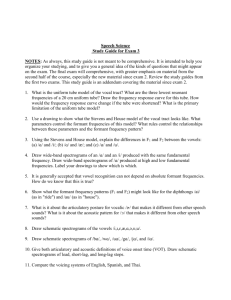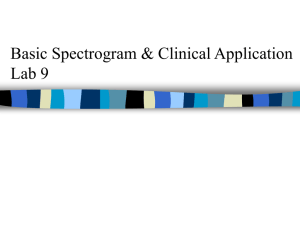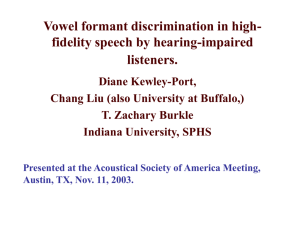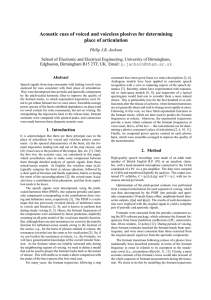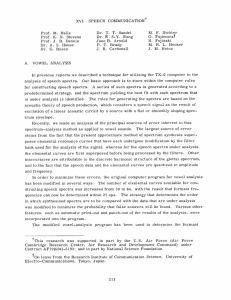24-Transitions-Perce.. - The Bases Produced Home Page
advertisement
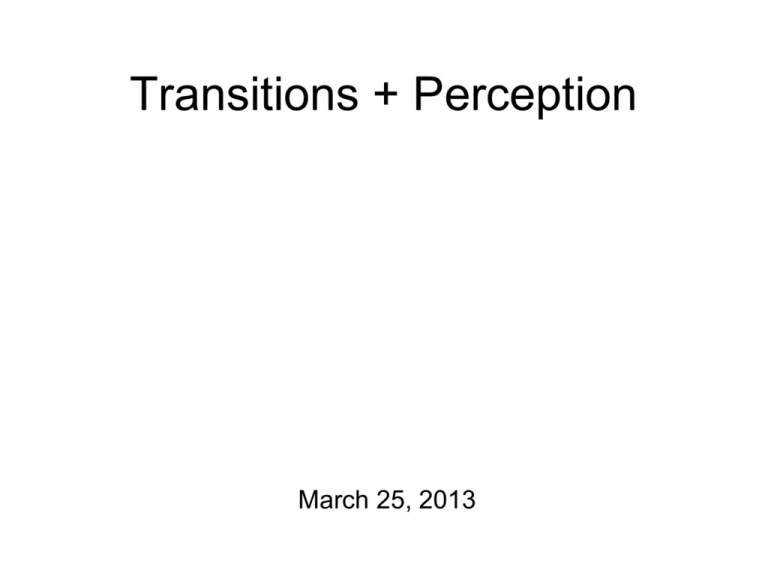
Transitions + Perception March 25, 2013 The Home Stretch • Guidelines for the final course project term paper and/or presentation • Papers will be due on Friday, April 26th • Our one and only presentation will happen on Monday, April 15th • Also: I have a perception homework for you • But we need to learn a few more things before we can get to it… • However, you can have your response sheets back! Laterals • Laterals are produced by constricting the sides of the tongue towards the center of the mouth. • Air may pass through the mouth on either both sides of the tongue… • or on just one side of the tongue. Lateral Palatography Lateral Acoustics • The central constriction traps the flow of air in a “side branch” of the vocal tract. • This side branch makes the acoustics of laterals similar to the acoustics of nasals. • In particular: acoustic energy trapped in the side branch sets up “anti-formants” • Also: some damping • …but not as much as in nasals. 17.5 cm 4 cm • Primary resonances of lateral approximants are the same as those of for vocal tract length of 17.5 cm • 500 Hz, 1500 Hz, 2500 Hz... • However, F1 is consistently low (300 - 400 Hz) • Anti-formant arises from a side tube of length 4cm • AF1 = 2125 Hz Laterals in Reality • Check out the Mid-Waghi and Zulu laterals in Praat Mid-Waghi: [alala] Velarization of [l] • [l] often has low F2 in English because it is velarized • = produced with the back of the tongue raised • = “dark” [l] • symbolized • Perturbation Theory flashback: • There is an anti-node for F2 in the velar region • constrictions there lower F2 Dark vs. Clear /l/ •/l/ often has low F2 in English because it is velarized. [alala] [l] vs. [n] • Laterals are usually more intense than nasals • less volume, less surface area = less damping • break between vowels and laterals is less clear [ ] [ n ] [l] vs. • [l] and are primarily distinguished by F3 • much lower in • Also: [l] usually has lower F2 in English [ ] [ ] Glides • Glides are vowel-like sonorants which are produced… • with slightly more constriction than a vowel at the same place of articulation. • Each glide corresponds to a different high vowel. Vowel Glide Place [i] [j] palatal (front, unrounded) [u] [w] labio-velar (back, rounded) [y] labial-palatal (front, rounded) velar (back, unrounded) • Each glide’s acoustics will be similar to those of the vowel they correspond to. Glide Acoustics • Glides look like high vowels, but… • are shorter than vowels • They also tend to lack “steady states” • and exhibit rapid transitions into (or from) vowels • hence: “glides” • Also: lower in intensity • especially in the higher formants [j] vs. [i] [w] vs. [u] Vowel-Glide-Vowel [iji] [uwu] More Glides [wi:] [ju:] Transitions • When stops are released, they go through a transition phase in between the stop and the vowel. • From stop to vowel: 1. Stop closure 2. Release burst 3. (glide-like) transition 4. “steady-state” vowel • Vowel-to-stop works the same way, in reverse, except: • Release burst (if any) comes after the stop closure. Stop Components closure voicing vowel formant transitions stop release burst • From Armenian: [bag] another closure Confusions • When the spectrogram was first invented… • phoneticians figured out quite quickly how to identify vowels from their spectral characteristics… • but they had a much harder time learning how to identify stops by their place of articulation. • Eventually they realized: • the formant transitions between vowels and stops provided a reliable cue to place of articulation. • Why? Formant Transitions • A: the resonant frequencies of the vocal tract change as stop gestures enter or exit the closure phase. • Simplest case: formant frequencies usually decrease near bilabial stops Stops vs. Glides “baby” • Note: formant transitions are more rapid for stops than they are for glides. “wave” Formant Transitions: alveolars • For other places of articulation, the formant transition that appears is more complex. • From front vowels into alveolars, F2 tends to slope downward. • From back vowels into alveolars, F2 tends to slope upwards. • In Perturbation Theory terms: • alveolars constrict somewhat closer to an F2 node (the palate) than to an F2 anti-node (the lips) [hid] [hæd] Formant Locus • Whether in a front vowel or back vowel context... • The formant transitions for alveolars tend to point to the same frequency value. ( 1650-1700 Hz) • This (apparent) frequency value is known as the locus of the formant transition. • In the ‘50s, researchers theorized: • the locus frequency can be used by listeners to reliably identify place of articulation. • However, velars posed a problem… Velar Transitions • Velar formant transitions do not always have a reliable locus frequency for F2. • Velars exhibit a lot of coarticulation with neighboring vowels. • Fronter (more palatal) next to front vowels • Locus is high: 1950-2000 Hz • Backer (more velar) next to back vowels • Locus is lower: < 1500 Hz • F2 and F3 often come together in velar transitions • “Velar Pinch” The Velar Pinch [bag] [bak] “Velar” Co-articulations Testing the Theory • The earliest experiments on place perception were conducted in the 1950s, using a speech synthesizer known as the pattern playback. Pattern Playback Picture Haskins Formant Transitions • Testing the perception of two-formant stimuli, with varying F2 transitions, led to a phenomenon known as categorical perception. Categorical Perception • Categorical perception = • continuous physical distinctions are perceived in discrete categories. • In the in-class experiment from last time: • There were 11 different syllable stimuli • They only differed in the locus of their F2 transition • F2 Locus range = 726 - 2217 Hz Source: http://www.ling.gu.se/~anders/KatPer/Applet/index.eng.html Stimulus #1 Stimulus #6 Stimulus #11 Example stimuli from the in-class experiment. Identification • In Categorical Perception: • All stimuli within a category boundary should be labeled the same. Discrimination • Original task: ABX discrimination • Stimuli across category boundaries should be 100% discriminable. • Stimuli within category boundaries should not be discriminable at all. In practice, categorical perception means: the discrimination function can be determined from the identification function.



